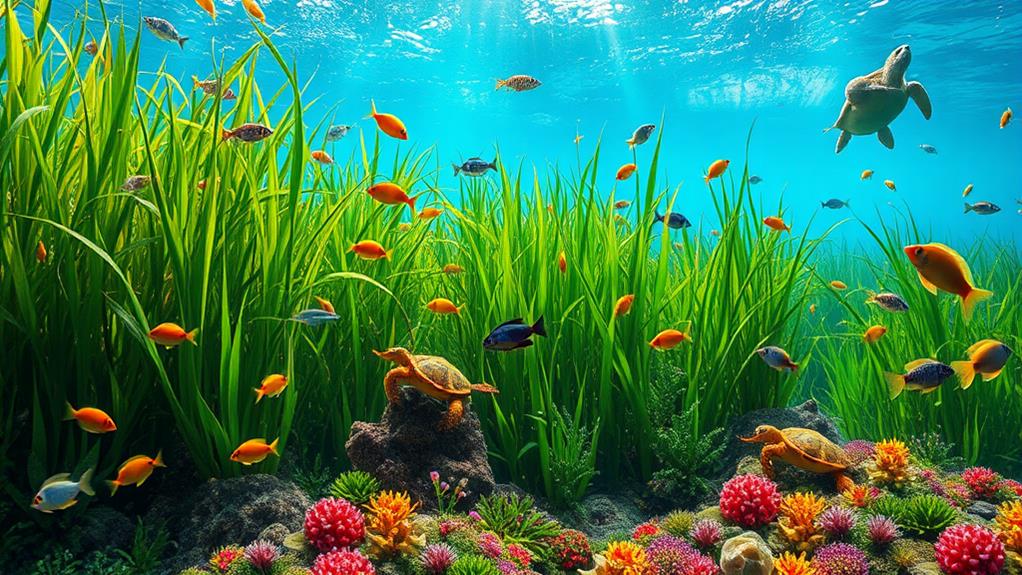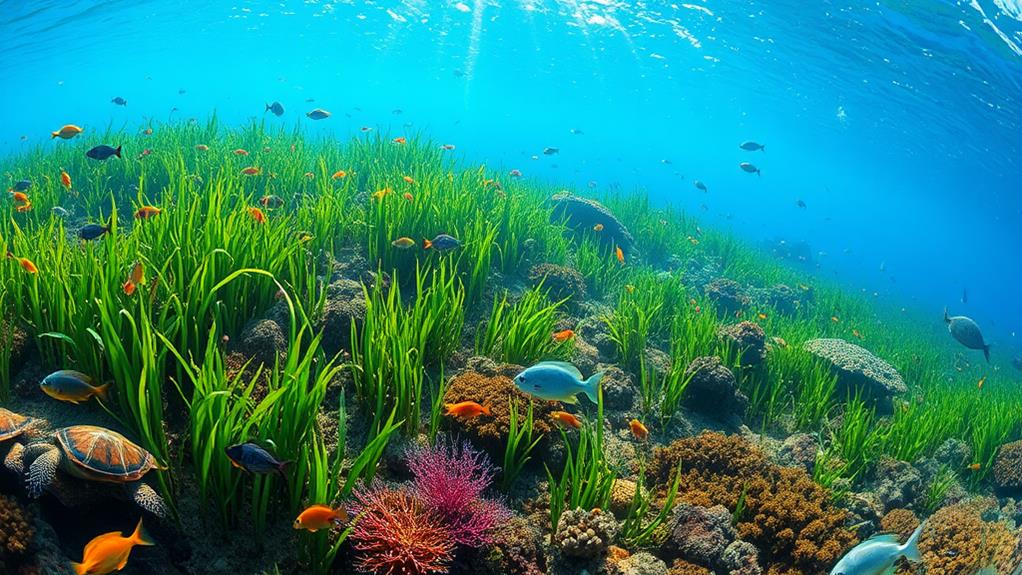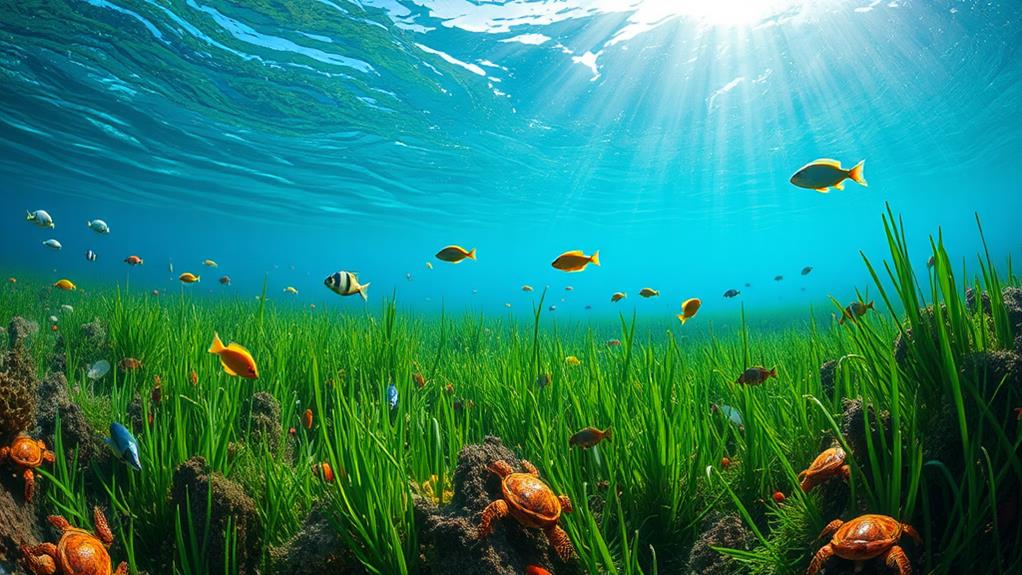Seagrass beds occupy a mere 0.2% of the ocean floor, yet they play a vital role in sustaining marine biodiversity and fisheries.
These ecosystems serve as critical nurseries for over 1,000 marine species, including 70% of targeted fish species that rely on them throughout their life cycles. For example, species like the Atlantic tarpon, bonefish, and permit rely on seagrass beds for food, shelter, and breeding grounds.
Seagrass beds also act as natural water filters, improving water quality and enhancing coastal health. By trapping sediments and pollutants, they mitigate excess nutrients and promote thriving aquatic environments. This, in turn, supports the growth of phytoplankton, the base of the marine food web.
Seagrass beds are essential for carbon sequestration and oxygen production. They absorb carbon dioxide from the atmosphere, reducing the impact of climate change, and produce oxygen through photosynthesis, supporting marine life.
Protecting these habitats is crucial for sustaining both marine life and local economies that depend on them.
Overview of Seagrass Ecosystems

Seagrass ecosystems, covering only 0.2% of the ocean floor, provide vital habitats for over 1,000 marine species. These flowering plants form nursery grounds for many important fish and play a crucial role in maintaining the balance of marine ecosystems. Found in shallow coastal waters around the globe, seagrasses support a vast array of marine life.
Seagrasses enhance water quality by trapping sediments and pollutants. Their photosynthetic activity releases up to 10 liters of oxygen per square meter daily, contributing to the overall health of coastal waters.
This process also stabilizes shorelines, mitigating erosion.
Seagrass meadows are significant for carbon sequestration, capturing an estimated 83 million metric tons of carbon annually. This helps combat climate change and supports the sustainability of marine environments.
Healthy seagrass ecosystems are imperative for local fisheries, with approximately 70% of targeted fish species depending on these habitats during various life stages. By supporting marine biodiversity and providing crucial services, seagrass meadows are indispensable to the sustainability of marine environments.
Understanding their role is vital for promoting conservation efforts and ensuring the health of our oceans.
Ecological Significance of Seagrass
Seagrass Meadows: Vital Ecosystems for Marine Life
Seagrass meadows support a vast array of marine species, with over 1,000 species relying on these ecosystems. This biodiversity is critical for maintaining healthy oceanic ecosystems, as seagrass meadows provide critical habitats and nurseries for juvenile fish, crustaceans, and invertebrates.
Water Quality and Carbon Sequestration
Seagrass meadows act as natural water filters, trapping sediments and pollutants to improve water clarity. Additionally, they sequester a significant amount of carbon, with an estimated 83 million metric tons of carbon sequestered annually. This helps mitigate climate change and supports overall ecosystem health.
Oxygen Production and Fisheries
Seagrass meadows release 10 liters of oxygen per square meter daily, which is essential for aquatic life. Furthermore, these ecosystems provide nurseries for juvenile fish, with 70% of targeted fish species depending on seagrass habitats throughout their life cycles. This highlights the importance of seagrass meadows in supporting thriving fisheries.
Ecosystem Health and Marine Biodiversity
The presence of healthy seagrass beds is directly correlated with thriving fisheries and enhanced marine biodiversity. By supporting such a vast array of species, seagrass meadows play a crucial role in maintaining the delicate balance of oceanic ecosystems.
Relationship With Manatees

Manatees rely heavily on seagrass meadows for nutrition. In fact, seagrass makes up over 90% of their diet, providing essential nutrients for growth and reproductive success. Healthy seagrass beds serve as critical foraging grounds, allowing manatees to graze effectively and maintain their well-being.
Manatees play a vital role in maintaining seagrass ecosystem health. By preventing overgrowth, their feeding habits promote biodiversity within these underwater habitats, creating a balanced environment where various marine species can thrive. For example, manatees help to maintain a diverse range of species by keeping seagrass beds from becoming too dense.
The decline of seagrass habitats poses a significant threat to manatee populations. Approximately 29% of seagrass habitats have been lost or degraded over the past 50 years, reducing available foraging grounds and jeopardizing the nutritional support manatees require for survival.
The relationship between manatees and seagrass beds is symbiotic. The presence of healthy seagrass supports manatees, while their grazing helps sustain these vital ecosystems.
Protecting seagrass habitats is essential for ensuring the future of both manatees and marine biodiversity.
Threats to Seagrass Habitats
Seagrass habitats face numerous threats that jeopardize their survival and the biodiversity they support.
Coastal development, nutrient loading from agricultural runoff, and pollution from failing septic tanks are major threats to seagrass habitats, contributing to significant habitat degradation.
Globally, seagrass habitats are vanishing at an alarming rate of approximately 1.5% annually, with a staggering 29% decline over the past century.
Physical disturbances, such as propeller scarring, have historically affected over 40,000 acres of seagrass, disrupting growth and threatening the diverse marine life that relies on these ecosystems.
Climate change intensifies these threats by increasing water temperatures and ocean acidification, which further compromise the health and resilience of seagrass.
Invasive species also present formidable challenges, outcompeting native varieties and leading to habitat loss and fragmentation.
The combined effects of these stressors create a precarious situation for seagrass habitats, highlighting the urgent need for awareness and action to protect these vital ecosystems and the biodiversity they harbor.
Conservation Strategies

Conservation Strategies
Addressing the multitude of threats facing seagrass habitats requires a multifaceted approach to conservation strategies. Three key components are essential to protect vital marine ecosystems and enhance biodiversity.
Habitat Protection is crucial to safeguard seagrass beds from harmful human activities. Establishing Marine Protected Areas (MPAs) allows ecosystems to thrive. For instance, MPAs prevent destructive fishing practices and coastal development that can damage seagrass habitats.
Seagrass Restoration rejuvenates degraded habitats. Projects like planting over 7.65 million seeds in Chesapeake Bay demonstrate the potential for restoration.
Restoration efforts not only support local biodiversity but also combat climate change by sequestering carbon. This approach helps to rebuild damaged ecosystems and promotes ecosystem services.
Community Engagement is essential to promote responsible boating and fishing practices.
Raising awareness about the importance of seagrass encourages local communities to minimize pollution and habitat damage. Educational initiatives and outreach programs can effectively engage local communities in seagrass conservation.
Ongoing research into seagrass ecology informs adaptive management strategies, enabling better responses to environmental stressors.
Legislative support for habitat protection and carbon credits through restoration initiatives further strengthens conservation efforts. By implementing these strategies, it's possible to sustain seagrass ecosystems and their vital role in marine biodiversity.
Economic Importance of Seagrass
Seagrass ecosystems are economic powerhouses that contribute significantly to coastal economies. In Florida, these habitats generate over $20 billion annually, underscoring their vital role in coastal economic health.
Seagrass habitats are essential for sustaining fisheries and marine biodiversity. Approximately 70% of commercially important fish species depend on seagrass during various life stages. For example, in Florida, species like shrimp, scallops, and grouper rely on seagrass beds for food, shelter, and breeding grounds.
Healthy seagrass meadows support recreational activities, injecting revenue into local economies. Scalloping, for instance, is a popular water-related activity that generates substantial revenue. In Hernando County, scalloping contributes significantly to the local economy, highlighting the direct economic reliance on robust seagrass habitats.
In Nature Coast, seagrass-dependent species contribute around $12 million in annual revenue.
The degradation of seagrass habitats poses a serious economic threat. If these ecosystems are damaged, approximately $1.2 billion in annual consumer spending linked to water-related activities is at risk. This potential loss emphasizes the importance of maintaining healthy seagrass beds not just for ecological balance, but also for the economic vitality of coastal communities.
Biodiversity Supported by Seagrass

Seagrass meadows serve as vital habitats in coastal ecosystems, supporting numerous marine species and enhancing marine biodiversity.
Seagrass meadows act as nurseries for juvenile marine animals, providing protection from predators and increasing their survival rates. These underwater environments are essential for supporting local fisheries.
Over 1,000 marine species call seagrass meadows home, including commercially important species like blue crabs and juvenile fish. This Habitat Diversity is crucial for maintaining marine biodiversity.
An acre of seagrass can support upwards of 40,000 fish and 50 million small invertebrates, showcasing the abundance of life these habitats sustain. This Rich Species Density is a testament to the importance of seagrass ecosystems.
The variety of species found in seagrass meadows contributes to intricate food webs, crucial for maintaining overall health and resilience of marine ecosystems.
These Complex Food Webs are essential for the stability of local fisheries.
Seagrass meadows play a critical role in maintaining marine biodiversity and ensuring the stability of local fisheries.
Protecting these habitats is vital for the health of our oceans.
Water Quality Benefits
Seagrass Meadows Enhance Water Quality in Coastal Ecosystems
Seagrass meadows significantly improve water quality in coastal ecosystems by performing various functions that support ecosystem health.
Sediment Trapping and Erosion Prevention
Seagrasses trap fine sediments and suspended particles, clarifying coastal waters and promoting essential light penetration for their growth.
Their complex root systems stabilize the sediment, preventing erosion and reducing sediment resuspension, which can cloud water and disrupt aquatic life.
Nutrient Recycling and Pollutant Filtration
Healthy seagrass beds remove excess nutrients, mitigating issues like algal blooms that can lead to hypoxic conditions detrimental to marine biodiversity.
Seagrasses also filter harmful pollutants, enhancing overall ecosystem health.
Oxygen Production and Its Importance
Seagrasses release oxygen (up to 10L/m²), which is vital for marine organisms.
This oxygen production supports the growth and survival of various marine species.
Overall Impact on Ecosystem Health
Through these functions, seagrass meadows significantly improve water quality, fostering thriving coastal ecosystems that support marine biodiversity.
Future of Seagrass Conservation

To ensure the future of seagrass conservation, effective conservation strategies must be implemented to combat the alarming 7% annual decline of coastal ecosystems.
Establish Marine Protected Areas (MPAs) to safeguard critical habitats, enabling biodiversity to thrive while promoting sustainable fisheries and coastal development practices.
For instance, MPAs can help protect seagrass meadows from destructive fishing practices and coastal development.
Enhance Community Engagement by involving local populations in conservation and restoration efforts, fostering a sense of ownership and responsibility.
Awareness programs can educate communities on the importance of seagrass, encouraging responsible practices that support ecosystem resilience.
For example, community-led initiatives can promote sustainable fishing practices and reduce pollution.
Invest in Restoration Efforts to recover degraded habitats.
Successful initiatives, such as planting 7.65 million seagrass seeds in Chesapeake Bay, demonstrate the potential for restoring habitats.
Scaling up these efforts globally is necessary to combat climate change and bolster biodiversity.
The UN's declaration of 2021-2030 as the Decade on Ecosystem Restoration emphasizes the urgency of these actions.
Questions and Answers
What Importance Are Seagrasses to Biodiversity and Our Fisheries?
Seagrasses support biodiversity and fisheries by serving as fish nurseries, providing a safe haven for juvenile fish to grow and develop. For example, species like the spotted seatrout and the red drum rely on seagrasses for their early life stages.
These habitats improve marine ecosystem health by filtering water and promoting nutrient cycling, which in turn supports a diverse range of marine life.
Seagrasses are biodiversity hotspots, supporting a variety of species that depend on them for food, shelter, and breeding grounds. For instance, sea turtles use seagrasses as a food source, while fish like the pinfish and the Gulf killifish feed on the invertebrates that live among the seagrass blades.
Seagrass conservation also aids in coastal protection, as the roots of these plants help to stabilize sediments and prevent erosion.
Seagrasses contribute to climate resilience by sequestering carbon from the atmosphere, which helps to mitigate the effects of climate change. In fact, seagrasses are among the most efficient carbon sinks in the ocean, with some meadows storing up to 35 times more carbon per hectare than tropical forests.
How Do Seagrass Meadows Contribute to Marine Biodiversity?
Seagrass meadows are crucial biodiversity hotspots that support a wide range of marine species. They provide nurseries for juvenile fish, allowing them to grow and develop in a safe environment. This is especially important for species like sea turtles, which rely on seagrass habitats for food and shelter.
Seagrass meadows also enhance ecosystem services in several ways. They sequester carbon from the atmosphere, which helps to mitigate climate change. Additionally, they cycle nutrients, converting them into forms that can be used by other organisms. This process helps to filter water and stabilize sediments, creating a healthier environment for marine life.
By providing coastal protection, seagrass habitats encourage the growth of diverse marine life. This leads to complex relationships among organisms, where species interact and depend on each other for survival.
For example, sea slugs rely on seagrass for food, while sea stars prey on the slugs. This intricate web of life contributes significantly to overall biodiversity, ensuring healthier marine ecosystems and promoting resilience against environmental changes.
What Is the Ecological Importance of Seagrass Beds?
Seagrass habitats are essential for maintaining healthy coastal ecosystems. They facilitate nutrient cycling and water filtration, which in turn enhance the overall quality of the environment. For instance, seagrass roots absorb excess nutrients, preventing them from entering the water column and promoting the growth of algae.
Seagrass beds provide a complex habitat that supports diverse marine life. The intricate network of seagrass blades and roots creates a nursery for many species, including fish, crustaceans, and mollusks. This habitat complexity fosters ecological interactions among species, ensuring a thriving marine ecosystem.
Seagrass beds are crucial for climate resilience. Through a process called carbon sequestration, seagrass captures significant amounts of greenhouse gases, such as carbon dioxide, from the atmosphere. This helps to mitigate the impacts of climate change.
Seagrass beds protect coastlines from erosion and storm damage. The roots of seagrass plants stabilize sediments, preventing erosion and reducing the risk of coastal damage during storms. This natural barrier also protects coastal communities and infrastructure from the impacts of storms.
By preserving seagrass beds, we can sustain marine biodiversity and support local fisheries and coastal communities. The health of these ecosystems is critical for maintaining the delicate balance of marine life, as well as the livelihoods of people who depend on the sea.
How Do Seagrass Beds Help Maintain the Health of Coral Reefs?
Seagrass beds are essential for maintaining the health of coral reefs. They enhance water clarity by trapping sediments and reducing turbidity, which allows coral reefs to receive the necessary sunlight for photosynthesis.
Additionally, seagrass roots stabilize sediments, preventing them from being resuspended and smothering coral reefs.
Seagrass beds also create vital habitats that support fish spawning and promote nutrient cycling. For example, fish like the spotted seatrout and the gray snapper rely on seagrass beds for shelter and food, and the decomposition of seagrass leaves releases nutrients that nourish coral ecosystems.
By acting as biodiversity corridors, seagrasses facilitate the movement of marine species, bolstering overall ecosystem resilience. This is evident in the migration patterns of species like sea turtles and dugongs, which use seagrass beds as a conduit to travel between coral reefs.
Lastly, seagrass meadows contribute to coastal resilience and climate regulation, ensuring healthier environments for both coral reefs and the diverse marine life they support.
